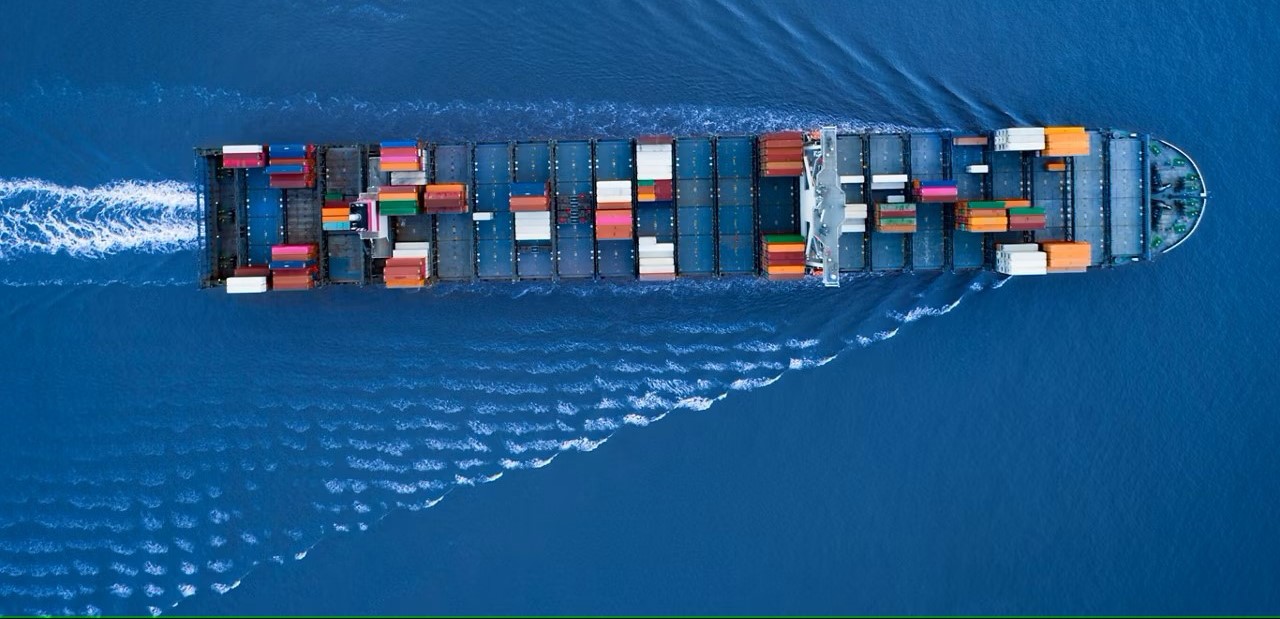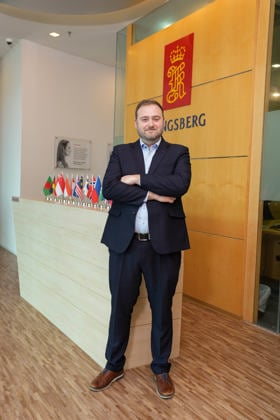
The green journey is no emission impossible
As decarbonisation in shipping gathers pace, there are more rules and regulations to consider. This may sound daunting, but Kongsberg Maritime’s expertise means smooth sailing all the way.
-
-
Craig TaylorSenior Manager PR & Communications
Key steps for successful decarbonisation planning
Navigating the energy transition in the shipping industry brings challenges – but a well-planned and carefully executed decarbonisation plan can help ensure success. Ship owners are facing choppy waters as they try to traverse the energy transition, with challenges including ever-evolving environmental regulations, the costs of compliance, and understanding the various technological and fuel advancements required to be future-ready.
However, adopting smarter, sustainable, and more efficient operations need not be a headache. Kongsberg Maritime is at the forefront of decarbonisation developments, and able to advise customers on options to achieve compliance and optimise efficiency for existing fleets and newbuilds.
The regulatory landscape
Two key regulations currently shaping the landscape are the Emissions Trading System (ETS) and the Carbon Intensity Indicator (CII) Index rules. The ETS, a key part of the European Union’s climate policy, aims to reduce greenhouse gas emissions by setting a cap on the total amount of emissions and allowing the trading of emission allowances. It began last year and means ships of 5,000 gross tonnage or above must monitor their greenhouse gas emissions on voyages to EEA ports.
By 2025, these ships must account for 70 per cent of their verified emissions, increasing to 100 per cent by 2026. This system encourages ship owners to invest in cleaner technologies to minimise their carbon footprint.The CII Index, introduced by the International Maritime Organization (IMO), measures the carbon intensity of ships, encouraging operators to enhance energy efficiency and reduce emissions. The CII rating system aims to reduce carbon intensity by 40 per cent by 2030 compared to 2008 levels.

Oskar Levander, Kongsberg Maritime’s Vice President Strategy and Business DevelopmentCompliance with ETS and CII not only ensures environmental responsibility but can also position ship owners competitively in a market where there is a growing focus on sustainable operations. Understanding and adapting to these regulations is essential for maintaining operational efficiency and long-term viability for ship owners.
Latest maritime regulations: shaping future energy choices
The FuelEU Maritime Regulation, effective from January 1, 2025, marks a significant step in the European Union’s efforts to decarbonise the maritime sector. FuelEU aims to reduce greenhouse gas (GHG) emissions from marine fuels, driving the transition to low-carbon and renewable energy sources.
Under the FuelEU Maritime Regulation, all commercial ships above 5,000 gross tonnage – the same threshold as ETS – calling at EU ports must reduce the GHG intensity of the energy used by 2 per cent compared to the baseline – an average intensity of the fleet in 2020.
These reduction targets will increase every five years, aiming for an 80 per cent reduction by 2050. Compliance involves collecting and reporting data on fuel usage and adopting Onshore Power Supply (OPS) technology at major EU ports by 2030.
In April 2025, the International Maritime Organization (IMO) also approved new net-zero regulations aimed at drastically reducing GHG emissions from the global shipping industry. These regulations, set to be formally adopted in October 2025 and enforced by 2027, represent a significant step towards achieving net-zero emissions by 2050. The IMO Net-Zero Framework introduces mandatory emissions limits and a global pricing mechanism for GHG emissions, making it the first of its kind to encompass an entire industry sector. Key elements include a new fuel standard for ships and a global economic measure, requiring ships to reduce their annual greenhouse gas fuel intensity (GFI) over time.
Oskar Levander adds: “The new IMO regulations set a clear cost on using fossil fuels and will be an essential driver for achieving the IMO GHG reduction targets. At Kongsberg Maritime, we are committed to supporting our customers in navigating these changes and adopting innovative technologies that meet these stringent standards.”
These measures will also apply to large ocean-going ships over 5,000 gross tonnage, which account for 85 per cent of total CO2 emissions from international shipping. The framework aims to accelerate the introduction of zero and
near-zero GHG fuels, technologies and energy sources.
Oskar continues: “While not a supplier of engines, Kongsberg Maritime can play a pivotal role in helping ship owners navigate these new regulations through the provision of integrated systems and alternative energy sources like batteries and wind-assisted propulsion. As a technology integrator, we offer consultancy services to guide owners in making informed decisions about energy choices and investments.”

Energy transition
Key elements in decarbonisation
One way in which Kongsberg Maritime visualises the challenge of reducing GHG emissions is to consider a triangle shape. In each corner lies a key element of the decarbonisation process: reducing energy consumption, maximising energy conversion efficiency and using clean energy sources and fuels.

Karl Alexander Wirén, Kongsberg Maritime’s Vice President, Aftermarket SalesYou cannot be in only one corner to solve the decarbonisation challenge. We work with our customers in all three. By reducing the amount of energy you use, you will produce fewer emissions.
Selecting a clean energy source also helps cut emissions. In the third corner of the triangle, Kongsberg Maritime helps ship owners maximise the energy efficiency of their chosen power source. Reducing energy consumption can involve “simple
things like cleaning the hull and operating at lower speeds,” Karl adds. However, there is no one-size-fits-all for vessels and operators, and this is where Kongsberg Maritime experts can really help ship owners by advising on the optimal solutions
and fuel options for their specific vessels and budgets. Karl continues: “The energy transition is as much about enhancing the energy efficiency of ships as it is about
transitioning to alternative fuels.”
Compliance and income generation
Becoming compliant with regulations means ship owners are having to improve their energy efficiency and reduce emissions. This can be achieved through the integration of technologies and solutions – a key strength of Kongsberg Maritime.
Additionally, the company’s knowledge of the regulatory landscape can help offer ship owners the opportunity to generate income from compliance.
This income stream stems from flexibility around compliance with the FuelEU Maritime Regulation. Owners have the option to pay the required penalties if they do not want to, or cannot, reduce their emissions. This becomes more expensive, over time, so if owners become over-compliant, “they can bank any surplus” to offset future deficits. By pooling surplus, an over compliant vessel can earn additional revenue from other pool members that do not reach the target.
The FuelEU regulations set maximum limits for yearly average GHG intensity of energy used by ships and mandate a gradual reduction in GHG intensity over time. The rules also state that container and passenger vessels must use onshore
power supply or zero-emissions technologies while in ports from 2030.
This makes shore power a much more attractive proposition. However, a challenge today, and towards 2030, is the onshore power infrastructure, so an initiative for zero emissions in port relies on the availability of the onshore
power grid.
Karl says: “This is an area where owners may need some clarity. FuelEU Maritime says a fuel with lower carbon intensity needs to be used. It’s a slow uptake – just 2 per cent lower than before [from 2025]. Gradually this requirement will increase and become quite steep, and this applies to all ships coming in and out of the EU.”
To comply, clean fuel or a clean energy source can be bought, but that is an expensive route. Most ship owners use blending, when renewable diesel is used with their other diesel or biogas with the LNG they use. Ship owners can also use wind propulsion or shore power, and if they charge from the grid or batteries it’s zero emission.
“Our experts can advise on future fuels and technological solutions to help owners increase efficiency, reduce fuel consumption and ensure compliance,” Karl adds. “If owners can reduce fuel consumption through efficiency, then it will be
cheaper to comply with the regulations. That’s a cost benefit from day one.”
Upgrade solutions
The best approach for ship owners is to start conversations with the Kongsberg Maritime experts as soon as possible. “Every owner has different requirements, and every vessel has its specific operation profile,” Karl adds. “That’s why we take a big-picture view of solutions and upgrades – to ensure value for money.”
“When retrofitting vessels, we start with the hull and propeller, look at the shaft-line and generation of electricity that can be optimised,” Karl explains. “Can we turn off the auxiliary? Can we produce power with lower emissions?”
“We have a wide range of technology that comes with great benefits for our customers. We see there is an increased interest in the market for installing hybrid shaft generators, both for new builds and upgrades. This is a great way to reduce the emissions for the electricity produced onboard.”
Hybrid shaft generators allow ships to draw power from the main engine’s propeller shaft to generate electricity while allowing the shaft speed to fluctuate. Kongsberg Maritime was an early pioneer of innovative hybrid shaft generators (HSG) and has been offering this, and ever-improving advancements, to customers for many years.
“The old, simple shaft generator worked at the same frequency as the propeller,” Karl explains. “So, to feed the right frequency to the switchboard there needs to be a constant speed, but that’s not the most efficient way of running the propeller in all conditions.”
A Kongsberg Maritime HSG contains a frequency converter so the propeller can be operated at variable speeds and still feed in the right frequency to the switchboard. Some energy transition technologies such as installing wind propulsion or air lubrication will increase the electrical demand in the ship, making the case for HSG even stronger.
After evaluating power generation, Kongsberg Maritime’s team extends their focus beyond the engine room to include the control room and bridge. They explore all options from their portfolio, ranging from standard lifetime extensions
of vessel automation to modern digital applications and smaller autonomy functions from larger development programs. This comprehensive support aims to optimise operations and enhance efficiency for customers.“It’s a whole-vessel approach to efficiency,” Karl concludes. “Owners can’t just fix one propeller and be compliant for the next ten years.”


